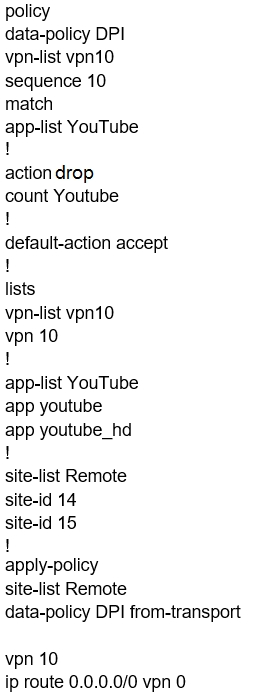Which configuration allows users to reach YouTube from a local Internet breakout?
A.

B.

C.

D.

Which configuration allows users to reach YouTube from a local Internet breakout?
A.

B.

C.

D.

The configuration that allows users to reach YouTube from a local Internet breakout is configuration A. For Direct Internet Access (DIA) to work, Network Address Translation (NAT) must be enabled on the Internet-facing interface within VPN 0, as defined in configuration A. This setup ensures that the traffic is redirected based on the NAT DIA route from the service-side VPN to the NAT-enabled transport-side interface, allowing users to reach external websites, such as YouTube, through a local breakout. Configuration B lacks the necessary NAT command, and configurations C and D utilize local policies incorrectly, as C does not implement DIA via NAT and D blocks YouTube traffic.
Literally can't be anything but A, it's the only one not blocking youtube AND implementing a local breakout via NAT on VPN 0. B doesn't do anything usefull, C and D look impressive but C doesn't implement DIA and D blocks youtube. Conclusion: A is Correct.
Thank you... I knew that the answer was incorrect.
I think it's A. Design Considerations on using NAT DIA: • Along with the configuration of a NAT DIA route within the service-side VPN, ensure that you enable NAT on the Internet-facing interface within VPN 0, as Internet traffic is redirected based on the NAT DIA route from the service side to the NAT-enabled transport side interface. • If you are using one of the routing protocols on the service-side VPN, ensure that you redistribute the NAT DIA route into it. • In NAT DIA, it is assumed that NAT/PAT is configured on one or more interfaces in VPN 0. • By default, an IP static route has an administrative distance of 1, a NAT DIA route has a distance of 6, and OMP has a distance of 251. Therefore, the NAT DIA route overwrites the OMP advertised default to prefer the local Internet exit, instead of taking the remote data centre Internet exit within a VPN.
A DIRECT INTERNET ACCESS
ill go with A
A because the main requirement is to enable nat on VPN0 and direct the service VPN default traffic to vpn0
Is in question, which policy?
A is Correct
C. local policy is required to do DIA.
Correct answer A
Absolutelty A. DIA can be done two ways: Using a default route for a VPN, or using centralized local policy. Options A and B use the default route method. A does it correctly, and B is missing the NAT command. C and D use the local policy method, but incorrectly. For DIA, the local policy has a nat command, and is applied on the service side, so Option C is wrong. Option D is obviously wrong on so many levels.
Correction (mistyped): should say "centralized data policy," not "centralized local policy."
A is Correct
Answer: A
Correct answer is C The question is specifically asking for traffic destined to youtube, not a default route to DIA.
This was suppose to say A "NOT C" "Big Lock Down FIngers"
1. Activate Network Address Translation (NAT) on the transport interface, where DIA should be used: vpn 0 ! interface ge0/0 description "DIA interface" ip address 192.168.109.4/24 nat <<<<==== NAT activated for a local DIA !
A is correct the Answer: As explained in figure7,withinthe direct Internet model, segmentation is leveraged by deploying centralized data policies or a NAT DIA route to leak Internet traffic from the service-side VPN (VPNs 0 -511,513 -65530) into the Internet transport VPN (VPN 0),which allows traffic to exit directly to the Internet through theNAT-enabled interface in VPN 0. https://www.cisco.com/c/dam/en/us/td/docs/solutions/CVD/SDWAN/sdwan-dia-deploy-2020aug.pdf
A. https://community.cisco.com/t5/sd-wan-and-cloud-networking/local-internet-breakout/m-p/4083996#M1992
A. Is the answer. https://www.cisco.com/c/en/us/support/docs/routers/sd-wan/215022-how-to-select-a-particular-site-to-be-a.html?dtid=osscdc000283
notice local breakout